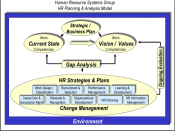Barrie, P. (1997 p.338) argues that "Those developments that improve organisational functioning, that enhance the ways in which the organisation members grow and benefit from participating and working in the organisation, and that help achieve the organisation's goals are the most valuable and sought after."ÃÂ To a certain extent, Human Resource Developers have the ability to execute all aspects of Barrie's statement. However to a greater extent, the flaws in their methods make the Human Resource Development (HRD) process ineffective. Human Resource (HR) Developers play a major role in instituting an organisation's orientation program. Orientation aims to provide new employees with initial development by educating them on areas such as group norms, organisational expectations and desired work practices all for the purpose of enhancing workforce effectiveness. However, HR Developers have encountered several barriers which makes orientation ineffective. For example, the failure to make orientation a continuous process.
Also, HR Developers often provide too much (or too little) information which can result in information overload and role overload, conflict and ambiguity. All of these factors can lead organisational ineffectiveness. HR Developers also engage in the training of employees. Training provides workers with a greater diversification of skills in order to become more productive and versatile. For training to contribute to enhancing workforce effectiveness, HR Developer's must ensure that they have top level support, skilled leadership, total involvement, feedback and effective communication and co-operation. However, time, money and staffing constraints make the HR Developer's training program ineffective due to it being inappropriately executed. Organisation Development (OD) aims to fulfil organisational objectives of creating a more versatile, flexible and efficient workplace. HR Developer's also assist in this process by recommending means such as job enrichment, job enlargement, organisational learning and organisational change. Organisations have incurred several problems with HR developer's programs in regard to the use of collaborative strategies and the over emphasis of the people variable in OD. Furthermore, HR Developer's have been known to impose customised change strategies which aren't tailored to the organisations objectives. As a result, OD becomes ineffective de to it not being able to satisfy organisational requirements. To a certain extent, HR developers play a role in enhancing organisational effectiveness, however, the numerous flaws in the execution of the HRD process means that their role is unable to further organisational effectiveness.
HR Developers can, to a certain extent, play a major role in enhancing workforce effectiveness through adequately performing the orientation process. An orientation program is an attempt to provide accurate information about the company culture, the job requirements and expectations. In other words, Rowden, R (1995 p. 366) states that "once on the job, new employees are coached, guided, instructed, and given informal, on-the-job training to learn the companies work practices."ÃÂ HR Developers can offer learning about group norms. Group norms can be classified as (Harris, D et. al. (1994 p.207) as the "typically unwritten rules of conduct established by group members to control behaviour within the group."ÃÂ The quicker and more thoroughly these rules are understood by the new employee, the smoother their transition will be. Organisation expectations can also be highlighted by the HR developer in orientation. For example, in my workplace it is expected that everyone comes to a shift 10 minutes before the shift actually starts. An orientation program can include education regarding the organisation's values, goals and policies. There are several financial benefits to a successful orientation which makes the process effective. For example an appropriate orientation program reduces start-up costs and turnover. This is because loss of production through lack of worker knowledge is prevented through successful employee orientation. Also newcomer stress and anxiety is significantly reduced as the re-assurance of knowledge makes it easier for the employee to adapt to the new business environment. As a result, the orientation program enables new employees to begin work heading in the right direction. Through appropriate and effective orientation, HR Developers do, to a certain extent, play a significant role in enhancing workforce effectiveness.
HR Developers can, to a certain extent, play a key role in enhancing workforce effectiveness through the HRD practice of an effective training and development program. Training is best described by Ivancevich, J (1197 p. 416) as "the systematic process of altering the behaviour of employees in a direction that will achieve organisation goals. Training is related to present job skills and abilities. It has a current orientation and helps employees master specific skills and abilities needed to be successful."ÃÂ Training has many evident advantages. For instance, it provides workers with new skills so that he/she can become more efficient. In addition, it provides workers with an enhanced level of education which can broaden their individual job prospects. Organisations can use training to instruct new, innovative and more productive methods so that each employee is capable of furthering their productivity levels. As a result, the organisation can become more efficient. Christoph, S. et. al. (1998 p. 26) Also believes that "Organisations use training to help individuals reach their potential and meet the cognitive demands of more technologically complex jobs."ÃÂ The way in which the HR developer executes a training program will decide whether the HRD practice enhances workforce effectiveness. Determining needs and objectives is the first important step of initiating the training program. Needs can include, those of the organisation and those of the individual. On the other hand, objectives may include, financial, market, social, human resource and growth. Top-level support is also needed as the process must gain complete and unconditional backing from the top executive. He/She must totally support the effort and be willing to commit the resources required for its successful completion. Total involvement of all personnel is an instrumental factor in executing a successful training program. The HR developer(s) must be able to effectively communicate and co-operate. Tracey, W. (1968 p. 18) believes that "Every effort must be made to let people know what is planned. This involves not only the people within training and development activity but other departments as well."ÃÂ Through carrying out effective communication workers can feel at ease knowing that they are being involved in the training and development procedure. In an analysis of a small business who conducts training programs which use effective communication, Rowden, R. (1995 p, 366) found that"ÃÂ the employees each saw and defined things in similar ways. The operations managers supported this premise: Everybody here understands what we want from them."ÃÂ HR developer(s) must have the ability to be able to engage in face-to-face contact on a regular basis. This will provide the ability for fellow colleagues to express their thoughts and ideas and it keeps the lines of communication more open. The HR Developer(s) must also provide complete and objective reports. Tracey, W. (1968 p. 19) insists that "all studies be complete, detailed and objective. A hard look at any operation is bound to produce some disappointing findings."ÃÂ Finally the HR Developer(s) must always provide continuous feedback relating to progress and problems. This is necessary to maintain the momentum of the training program and obtain the appropriate level of commitment. Through the use of these methods, the HR Developer can instruct a successful training program which may, to a certain extent, enhance workforce effectiveness.
Through effective organisational development (OD), HR Developers can, to an extent, play a major role in enhancing workforce effectiveness. OD is best described by Gilley, W & Eggland, S. (1989 p. 75) to be "a system wide process of data collection, diagnosis, action planning, intervention, and evaluation aimed at (1) enhancing congruence between organisational structure, process, strategy, people and culture; (2) developing new and creative organisational solutions; and (3) developing the organisations self renewing capacity"ÃÂ A HR Developer can institute OD through several avenues. For example, initiating change through benchmarking. Karash, R. (1998) believes that "The idea behind benchmarking is simple; the most effective way to implement change is by learning from the positive experienced of other organisations. Why re-invent the wheel? Why not look at what others have done that could increase your own productivity and quality? Benchmarking enables a HR Developer to use other organisations methods of success and tailor them to their own companies needs and situation. Other examples include business process re-engineering (BPR), management by objectives (MBO) and learning organisations. All of these have the benefits of creating a more versatile, innovative, flexible and efficient workplace.
The method in which the HR Developer uses to carry out OD will determine whether or not it is effective in enhancing workforce effectiveness. There are several interdependent elements which need to be addressed by the HR Developer in order to carry out successful OD. Karash, R. (1998) believes that "the HR Developer needs to understand the vision or a set of guiding principles make clear what the organisation stands for and what its members are trying to create."ÃÂ Secondly, the HR Developer needs to assess what methods and tools are needed in the pursuit of these guiding principles. Finally, the HR Developer must become accustomed to what innovations and infrastructure are needed to support learning. Examples may include new information systems, autonomous working teams, new work processes. These elements must be addressed by the HR Developer to ensure that the OD program is successful. If the OD program follows these guidelines and is a success, the HR Developer does, to an extent, play a major role in enhancing workforce effectiveness.
To a much larger extent, the role played by HR developers in enhancing workforce effectiveness is only small, because their methods of instituting HRD has many evident flaws. One such flaw is the fact that HR developers often do not execute an appropriate orientation program. Harris, D and DiSimone, R. (1994 p. 227) believes that "Orientation programs are no more immune from problems than any other HRD intervention."ÃÂ One significant problem that could lead to enhancing workforce ineffectiveness is information overload. This is a particularly common problem which involves a HR Developer giving a newcomer too much information too quickly. As a consequence, the employee's stress level increases and efficiency drops. Another common error that has been made by HR developers when conducting orientation is the "one-shot"ÃÂ mentality. It has been perceived by some HR Developers that Orientation only spans across one or two days at most. The reasoning is that it is an unimportant activity to drag across weeks or months, as it is too costly. On the other hand, Harris, D. and DiSimone, R. (1994 p.223) believe that "One of the most important elements of an effective orientation experience is frequent interaction between the newcomers and their supervisors, co-workers, and other organisation members"ÃÂ. There are several significant consequences of a HR Developers choice to adopt this hap hazard method. For example, it could lead to employee role ambiguity and a lack of a need for affiliation, the result being newcomer inefficiency. An effective orientation program involves the HR Developer undertaking continuous means of orientation over an appropriate period of time to ensure that the optimum amount of productivity can be achieved by the new employee. HR Developers often make the mistake of causing role conflict and role overload which is also detrimental to the newcomers productivity levels. Role Conflict can result from a HR Developer communicating mixed messages about what is expected from the individual employee. Role overload is where the employee believes that the role is more than he/she can reasonably do. This is a result of Information overload on behalf of the HR Developer. As a result of HR Developer errors in executing orientation programs, the role played by these professionals in enhancing workforce effectiveness is, to a large extent, a minimal one.
The numerous errors made by HR Developers when conducting training and development programs has meant that, to a large extent, the role played by these professionals in enhancing workforce effectiveness is minor. There are several common errors HR Developers make when attempting to conduct a training and development program within an organisation. Problems may occur to due inadequate staffing. A training and development program is a time consuming, complex activity. More often than not, the HR Developer will fail to allocate enough personnel to ensure that the program is run effectively. These workers are burdened with an increased workload which isn't usually desired. As a result, these workers become bitter and efficiency drops, which inturn means that the program is already being ineffective. Another problem is that there is some staff and faculty resistance to training programs. Tracey, W. (1968 p.17) believes that "evaluation sometimes becomes a threat, direct or implied, to position status, and the opportunities of every position in the organisation being appraised"ÃÂ This barrier is often overlooked by the HR Developer. As a result, the HR Developer may find it increasing difficult to gain full commitment from employees, thus, the program is susceptible to being ineffective. Another major problem is outlined by Christoph, T. et. al (1998 p. 27) who believe that "organisational constraints such as time, money, and staff expertise often create barriers that prevent proper evaluation."ÃÂ Commonly, the HR Developer fails to deal with these barriers appropriately, which results in the training program being ineffective. To a large extent, HR Developers play only a minor role in increasing workforce effectiveness due to the evident flaws in the execution of their practice.
As a result of numerous errors when implementing OD, the HR Developers role in enhancing workforce effectiveness is, to a significant extent, a minor one. The process of implementing OD has paved the way for numerous problems and inconsistencies for HR Developers. One such problem is in regard to the implementation on a general level. Some HR Developers are actually resorting to universalist "one size fits all"ÃÂ methods. Bamber, G. (1992, p.96) warns that HR Developers need "to choose an appropriately customised change strategy, rather than rely on packaged change solutions that may be inappropriate to their organisation."ÃÂ Problems may occur due to the fact that the strategy doesn't blend with the organisations culture, size and staff expertise. Consequently, the implementation of OD would infact be ineffective and a waste of time and money. Another major problem is the HR Developer resorts to traditional methods of implementation. Hersey, P. (1982) believes that "there are more OD intervention failures than successes. Using the same strategy for change all the time will lead to effective change in some situations but in many others might be ineffective, Thus, there is no one best strategy for change."ÃÂ In addition, The failure of HR Developers to deal with a lack of top level support for OD and staff resistance will also create a shaky foundation for OD. Often, HR Developers fail to address such problems, which results in a haphazard attempt at OD, which is more often than not, very ineffective. HR Developer's errors regarding the implementation methods and failure to deal with posing threats to OD has meant that the role played by these professionals in enhancing workforce effectiveness is, to a large degree, a minor one.
Overall the role played by HR Developers in enhancing workforce effectiveness could be significant, however, the numerous errors made by these professionals could result in it being a liability rather than an asset. Through Orientation, HR Developers can provide employees with enough adequate knowledge to commence business practices heading in the right direction and working as efficiently as possible. Training enhances the employees range of skills and provides them with innovative working methods to increase their productivity. Finally, OD enables the entire workforce to become more dynamic, and aims at aligning employee goals to that of the organisation. The result being a more direct organisation with a clearer vision to achieving organisational efficiency and effectiveness. However, common mistakes made by HR Developers whilst attempting to conduct these HRD practices has meant that HR Developers don't play a major role in enhancing workforce effectiveness. Problems in regard to orientation being too short, irrelevant and/or too informative has often resulted in an ineffective orientation program. Consequently the organisations precious resources haven't been adequately utilised. Common mistakes made whilst implementing a sufficient training program has the potential of jeopardising the training's effectiveness in boosting workforce innovation and skilling. Those HR Developers who engage in conducting training programs fail to enhance workforce effectiveness through training. Finally, HR Developers are prone to creating problems and inconsistencies associated with OD implementation. Once again, this could prevent the OD aim of boosting workforce effectiveness. HR Developers have the ability to utilise adequate HRD programs to enhance workforce effectiveness, however, the mistakes made by these professionals in attempting to execute these practices has resulted in these programs being ineffective.
Reference List Karash, R. (1998) "Benchmarking - Learning from Best Practice"ÃÂ accessed: 22/10/98 www.timesystem.com/timesystem/methods/benchmark.htm Barrie, P. (1997) "Competence, efficiency, and Organisational Learning"ÃÂ Human Resource Development Quarterly Spring Vol. 8 pp. 338-400 Bamber, G, (1992) "The Handbook Of Human Resource Management"ÃÂ Blackwell Publishers, Australia Hersey, P. (1982) "Management Of Organisational Behaviour"ÃÂ Prentice-Hall, Australia Rowden, R. (1995) "HRD in Successful Small to Mid-Sized Businesses"ÃÂ Human Resource Development Quarterly Vol. 18 pp.365-366 Tracey, W. (1968) "Evaluating Training & Development Systems"ÃÂ USA Management Association, USA pp. 16-20 Christoph, S. (1998) "Overcoming Barriers To Training Utilising Technology"ÃÂ Human Resource Development Quarterly Spring Vol. 9 pp. 26-30 Ivancevich, J. (1998) "Human Resource Management"ÃÂ McGraw-Hill, USA.
Gilley, J. & Eggland, S. (1989) "Principles Of Human Resource Development"ÃÂ Corporate & Professional Publishing Group, USA.
Harris, D. & DiSimone, R. (1994) "Human Resource Development"ÃÂ The Dryden Press, USA.


